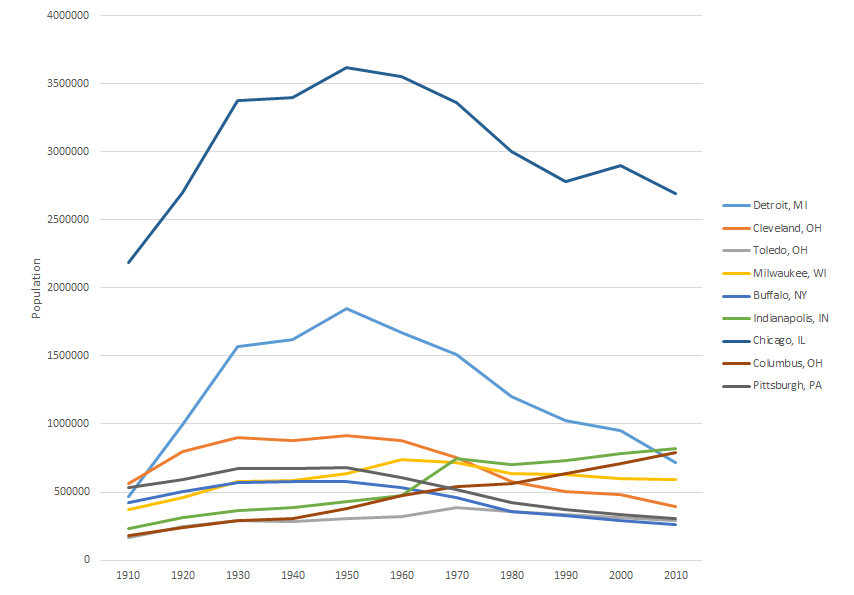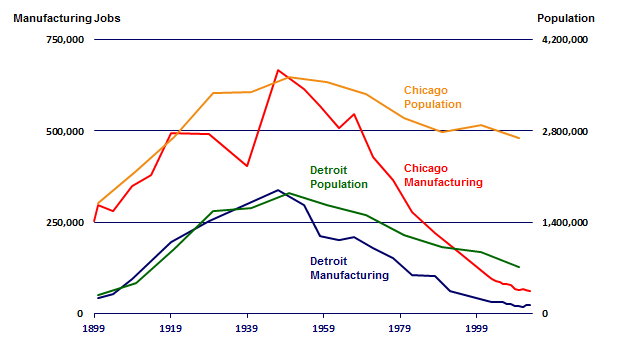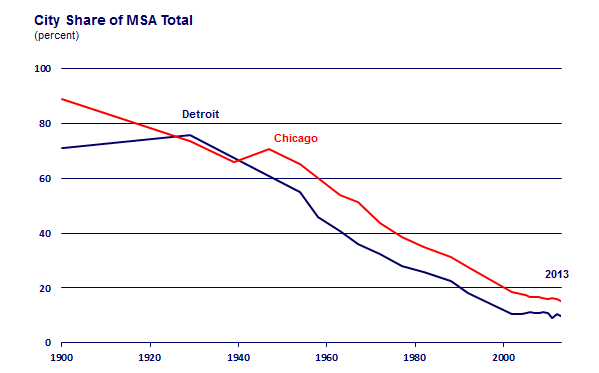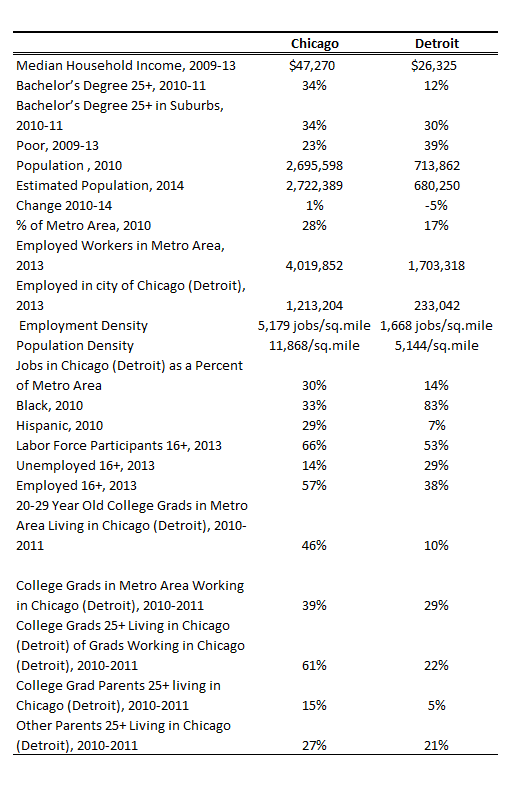Why Chicago is not Detroit
Over the past decade, 17 of the 20 largest cities in the United States gained population. Recent academic studies on these trends have attributed them to changes in residential preferences, the location of skilled jobs, and cultural amenities. Both Chicago (third largest) and Detroit (18th) are exceptions to these trends. The population of the city of Chicago declined modestly from 2.9 million in 2000 to 2.7 million in 2010 after increasing during the 1990s. The population of the city of Detroit has declined more drastically over time from a peak of 1.8 million in 1950 to about 700,000 today; the city filed for bankruptcy in 2013. Since 2010, the population of the city of Chicago has increased modestly (1%), while Detroit’s population has continued to decline. Figure 1 shows population trends for Chicago, Detroit, and other Industrial Belt cities, which have traditionally depended heavily on manufacturing for employment. While Chicago remains much larger than the others despite recent sluggish growth, Detroit has seen a dramatic change in its position.
Figure 1. Major city populations over time

Due to worsening fiscal problems and a rising homicide rate, Chicago’s prospects have recently been equated with Detroit’s, at least by the popular press. LeDuff1 writes in The New York Times “So Detroit files for bankruptcy…Pay close attention because it may be coming to you soon…Chicago.” An Investor’s Business Daily editorial notes that “Chicago appears to be following Detroit’s lead to financial disaster.”2 An article in the Financial Times suggests that Chicago’s problems are not too different from Detroit’s.3 And so on.
For one, both places have been severely challenged by loss of manufacturing activity. Detroit and Chicago have lost over 100,000 and 300,000 manufacturing jobs, respectively, since the late 1970s; other midwestern cities (Milwaukee, Cleveland) have not been far behind. The inverse relationship between an historic MSA concentration of manufacturing jobs and subsequent growth from 1969 onward is evident for the most prominent Great Lakes metropolitan areas. More broadly, the growth-retarding effect from manufacturing on U.S. metropolitan areas over the 1960–90 period has been documented in a statistical study by Harvard’s Edward Glaeser.4 As evidenced in figure 2, manufacturing employment losses and depopulation within the central city were contemporaneous in both Detroit and Chicago.
Figure 2. Detroit and Chicago population and manufacturing

Declines in manufacturing jobs are a result of improvements in manufacturing productivity as well as the movement of production elsewhere including both suburban areas and overseas. For example, data for Michigan indicates that vehicle production in 2015 was at about the same level as 1990. However, employment in producing vehicles over this period declined by about one-half.
Suburbanization has taken no less a toll on central city manufacturing employment in both Chicago and Detroit alike. In the Chicago metropolitan area, only 9% of jobs are now in the manufacturing sector, while manufacturing accounts for 13% of jobs in the Detroit area. In the city of Chicago, only 6% of jobs remain in manufacturing and 10% in the city of Detroit. As reported by John McDonald for Detroit circa 1950, 61% of the Detroit area’s manufacturing jobs were to be found in the city, with another 13% in adjacent Dearborn, domicile of Ford Motor Company.5 The entire range of the city-suburb split in manufacturing jobs for both MSAs can be seen in figure 3. The advent of controlled access divided highways pulled manufacturing jobs outward within metropolitan areas to take advantage of lower land prices and lower shipping costs.
Figure 3. Manufacturing employees

Although both Chicago and Detroit lost a large number of jobs in manufacturing, it is also evident from figure 2 that the city of Chicago withstood the manufacturing exodus more robustly than Detroit. Unlike Detroit, its population did not decline apace with manufacturing from 1950 onward. Similarly, it did not experience the same degree of job declines. More recently, for example, over the 2000 to 2010 period, metropolitan Detroit experienced a 21.2% decline in employment, while the Chicago metropolitan area lost 7.7% of its jobs. Indeed, the past decade was disastrous for Detroit relative to Chicago. About one in four workers were unemployed in the motor city by the end of the decade. In Chicago, the unemployment rate peaked at a little more than one in ten workers (see figure 4).
Figure 4. Unemployment rate

The resident population of the city of Detroit has also come to be characterized by a much higher degree of poverty and minority population. The share of households in poverty approaches four in ten in the city of Detroit, compared with 23% in Chicago. According to the latest decennial Census, the Detroit population overwhelmingly identifies as “black” (83%), up from 29% in 1960. Owing to the city’s economic collapse and to the suburbanization of (mostly white) population, by 1990 Detroit had become one of the most racially divided metropolitan areas in the United States. Social and economic issues arising from racial polarization since early in the twentieth century have been cited as a major constraint on the growth and development of Detroit and its suburbs.
Table 1. Selected statistics on the cities of Chicago and Detroit

Chicago’s racial/ethnic groups also tend to be highly segregated; however, the overall composition of the city’s population is more balanced. Approximately 32% of Census respondents identify as black (including those reporting Hispanic background); 45% report as non-Hispanic white; and 28% as Hispanic. More than 20% of Chicago residents are foreign born. Despite the impression of a balanced population that such figures suggest, racial isolation in Chicago is very similar to that in Detroit when measured on a block to block basis.
Although Chicago has many of Detroit’s problems and more than twice the number of residents living in poverty, Chicago also has many positive features relative to Detroit.
One of the reasons that one might be more optimistic about Chicago’s future is that, in spite of declines in population growth, the city of Chicago has become increasingly attractive to non-Hispanic white college graduates, while the inner-ring of suburbs of Chicago have become more attractive to African-American and Hispanic college graduates. Further, within the city of Chicago, household locations along Chicago’s lakeshore (particularly on the north side of the city), have become particularly attractive to more affluent, college-educated households. Studies indicate that the attractiveness of the city of Chicago to college graduates is at least partly related to growth in skilled jobs in and around the central business district.
Although there are recent indications to the contrary, Detroit has been less successful in attracting resident college graduates. Only 12% of the population twenty-five and older in the city of Detroit are college graduates. In the city of Chicago, 34% of the adult population has at least a bachelor’s degree. In popular areas of Chicago such as Lincoln Park, the vast majority of adults have at least a bachelor’s degree. Further, about half of the twenty-something college graduates in the Chicago metropolitan area live in the city of Chicago, while only 10% of college graduates in their 20s in the Detroit metropolitan area live in the city of Detroit. For college graduates with a school-age child, the percentage living in the city of Detroit is even lower (5%), versus 15% for Chicago. Of the college graduates working in the city of Detroit, only 22% live there. In the case of Chicago, the corresponding statistic is 61%.
Further, median household income in the city of Detroit is only a little over half of median income in Chicago. The poverty rate in Detroit is almost twice as high as Chicago’s, although the city of Chicago has almost twice as many poor residents. The city of Chicago employs about four times as many people as the city of Detroit. About 30% of the jobs in the Chicago metropolitan area are in the city of Chicago, while the corresponding statistic for Detroit is only 14%.
Why Are Chicago’s Prospects Brighter?
For one, Chicago began the era of de-industrialization with a more diversified economy with which to reinvent itself, especially in business services and financial services. In addition to its manufacturing (and goods transportation) prowess, Chicago has long been a purveyor of business and business-meeting services, retail, and financial services to the surrounding Midwest region and beyond. For example, Chicago’s large exchange-traded derivatives industry evolved from the city’s role as a nineteenth century market and wholesale distributor of grain, lumber, and meat. Its highly concentrated management consulting industry owes its twenty-first century success in part to the need of New York City financial houses to closely appraise the operations of Midwest manufacturing companies in the issuance of corporate debt. And the nexus of passenger railroad lines and (later) passenger air travel in Chicago cultivated one of the nation’s leading industries in business meetings and conventions. Accordingly, the profound exodus of manufacturing that occurred from almost all large U.S. cities did not devastate Chicago’s job base to the same degree as happened in Detroit and some other Midwest cities, although some parts of Chicago were hit hard. Admittedly, the Detroit area also maintains very strong business services industries, largely related to the auto industry, but for the most part these services are in suburban locations. In Chicago, many service businesses remain in the city.
Figures 2 and 3 show trends in population and manufacturing in Chicago and Detroit from 1900 to date. In both cities, one can see the spectacular rise in both manufacturing and population to 1950 followed by an equally spectacular decline. However, while population declines in Chicago have been profound, they diverge markedly from the Detroit experience. Nonetheless, much like Detroit, vast neighborhood areas of the city of Chicago were also impoverished by job and population flight to the suburbs, especially those neighborhoods that depended on the middle-income jobs associated with freight and manufacturing. Wages and jobs outside of the central area of Chicago have declined, even while the central area has prospered. Today, many Chicago neighborhoods find themselves challenged in the same ways as neighborhoods in Detroit and other industrial cities by poverty, violence, sub-standard housing, and a lack of immediate and accessible economic opportunities.
Chicago has arguably developed a stronger reputation as a city in which to do business than Detroit and some other midwestern cities. At the turn of this century, Chicago began positioning itself to be one of the emerging “global cities” that had successfully forged commercial connections to other cities of its kind around the world. Global cities are characterized by the most skilled occupations and activities in business services, finance, education, and technology; well-educated residents; forward-looking business leaders; and globally connected transportation and communications networks, among other attributes.
Owing to their strategic importance and global reach, corporate headquarters operations have become a hallmark of success for global cities. Early last decade, Chicago became the global headquarters of Boeing. Since then, the city has attracted Archer Daniels Midland, GE Healthcare, Oscar Mayer, and ConAgra, among others. Relocation of headquarters from the suburbs of Chicago to the central city has also taken place, including United (Air), Kraft Heinz, and Motorola Mobility.
In Detroit, both the IT software company Compuware and Quicken Loans have relocated operations from the suburbs to the downtown area (in 2003 and 2010, respectively). However, the scale of these moves falls far short of similar activity in Chicago.
Some argue that headquarters operations have downsized over time, representing far fewer direct jobs than in the past when headquarters often included back office, research, advertising, and payroll processing operations. However, the presence of headquarters is coincident with a much vaster nearby network of financial and business services, many of which are supported by colocation with the strategic headquarters of corporations.
The upshot then is that, even though the older industrial neighborhoods of Chicago share many of the same challenges as those of Detroit, Chicago has been better able to withstand the decline of industrial production. Whereas the city of Chicago has about four times as many people as the city of Detroit, Chicago has ten times as many jobs in finance, eight times as many jobs in professional services, six times as many jobs in education, and five times as many jobs in accommodation and food services. Since 1998, the Chicago area has gained almost 60,000 jobs in business services, while Detroit has lost over 35,000 jobs in the sector. During this period, Chicago also gained more than 20,000 jobs in colleges and universities, while Detroit gained none.
It is clear that Detroit needs to diversify its legacy industrial clusters as well as to build on them. This focus on industrial rebirth includes further specialization in the auto industry—especially R&D, as well as logistics and transportation, engineering and design, technology start-ups, and business services and finance. Indeed, diversification to a technology-oriented industrial structure has raised fortunes of old industrial regions elsewhere, with the Boston area being a prominent example.
We would note that a number of Rust Belt cities with about as many jobs as Detroit, including Cleveland, St. Louis, Milwaukee, and Pittsburgh have significantly fewer people living in them. This implies that Detroit’s population may not yet have reached a floor. Unlike Detroit, the city of Chicago remains an attractive place to work and live, especially for young college graduates. This could change over time if Detroit can reinvent itself and make further improvements in the delivery of basic public services, especially basic education and public safety. Chicago faces many of the same challenges in improving public services, and in putting its underlying fiscal affairs on a sounder footing.
William Sander, Professor of Economics, DePaul University, Chicago.
William Testa, President and Director of Regional Programs, Federal Reserve Bank of Chicago
A preliminary version of this paper was presented at Inner City Economic Development Summit in Detroit, September 2015.
Footnotes
1 LeDuff, Charlie. 2013. “Come see Detroit, America’s future.” The New York Times, July 24.
2 Investor’s Business Daily. 2013. “Emmanuel’s Chicago is on the path to be the next Detroit.” August 7.
3 Sender, Henny, Stephen Foley, and Richard, McGregor. 2013. “Descent into despair.” The Financial Times. July 26.
4 Glaeser, Edward, Jose A. Scheinkman, and Andrei Shleifer. 1995.”Economic Growth in a Cross-Section of Cities,” Journal of Monetary Economics 36 (1): 117-143.
5 McDonald, John F. 2013. “What Happened To and In Detroit?” unpublished paper.








